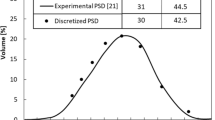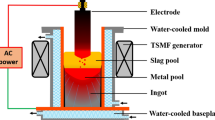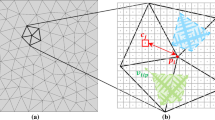Abstract
The selective orientation of grains during laser powder bed fusion (L-PBF) leads to anisotropy in mechanical properties. The current understanding of the evolution between the different morphologies of the grains is still limited. The present work is aimed at revealing the grain evolution process through the development of a coupled discrete elemental method-computational fluid dynamics-metacellular automata model. The results show that most of the grains observed through characterization experiments are irregularly shaped columnar grains and exhibit anisotropy in mechanical property tests. The grains observed in the simulations can be generalized into four types: V-shaped grain, slanted grain, vertical grain, and equiaxial grain. During the overlapping of interlayer and intertrack, some of the slanted grains are retained and others grow into V-shaped grains. In addition, some of the V-shaped grains coarsen during remelting and resolidification and subsume the slanted grains in the direction in which they grow, eventually developing into coarse vertical grain. Therefore, an appropriate increase in hatch distance is beneficial to reduce anisotropy. This study contributes to an in-depth understanding of grain transformation during remelting and resolidification and guides the design of specific microstructures.















Similar content being viewed by others
References
Chen L, He Y, Yang Y, Niu S, Ren H (2017) The research status and development trend of additive manufacturing technology. Int J Adv Manuf Technol 89(9):3651–3660. https://doi.org/10.1007/s00170-016-9335-4
Tan C, Weng F, Sui S, Chew Y, Bi G (2021) Progress and perspectives in laser additive manufacturing of key aeroengine materials. Int J Mach Tools Manuf 170:103804. https://doi.org/10.1016/j.ijmachtools.2020.103592
Thomas D, Gleadall A (2022) Advanced metal transfer additive manufacturing of high temperature turbine blades. Int J Adv Manuf Technol 120(9):6325–6335. https://doi.org/10.1007/s00170-022-09176-2
DebRoy T, Wei HL, Zuback JS, Mukherjee T, Elmer JW, Milewski JO, Beese AM, Wilson-Heid A, De A, Zhang W (2018) Additive manufacturing of metallic components – process, structure and properties. Prog Mater Sci 92:112–224. https://doi.org/10.1016/j.pmatsci.2017.10.001
Lu H, Pan J, Gu Y, Xiao J, Ma C, Yu N, Li H (2023) Comparison of melt evolution and flow mechanisms of Inconel 718, Ti6Al4V, 304 stainless steel, and AlSi10Mg manufactured by laser powder bed fusion, structures, and properties after heat treatments. Mater Sci Eng A 865:144649. https://doi.org/10.1016/j.msea.2023.144649
Eskandari Sabzi H, Rivera-Díaz-del-Castillo PE (2019) Defect prevention in selective laser melting components: compositional and process effects. Materials 12(22):3791. https://doi.org/10.3390/ma12223791
Yadroitsev I, Smurov I (2010) Selective laser melting technology: from the single laser melted track stability to 3D parts of complex shape. Phys Procedia 5:551–560. https://doi.org/10.1016/j.phpro.2010.08.083
Zhao C, Fezzaa K, Cunningham RW, Wen H, De Carlo F, Chen L, Rollett AD, Sun T (2017) Real-time monitoring of laser powder bed fusion process using high-speed X-ray imaging and diffraction. Sci Rep 7(1):3602. https://doi.org/10.1038/s41598-017-03761-2
Chen Y, Lu F, Zhang K, Nie P, Elmi Hosseini SR, Feng K, Li Z (2016) Dendritic microstructure and hot cracking of laser additive manufactured Inconel 718 under improved base cooling. J Alloys Compd 670:312–321. https://doi.org/10.1016/j.jallcom.2016.01.250
Chen H, Yan W (2020) Spattering and denudation in laser powder bed fusion process: multiphase flow modelling. Acta Mater 196:154–167. https://doi.org/10.1016/j.actamat.2020.06.033
Zhao C, Parab ND, Li X, Fezzaa K, Tan W, Rollett AD, Sun T (2020) Critical instability at moving keyhole tip generates porosity in laser melting. Science 370(6520):1080–1086. https://doi.org/10.1126/science.abd1587
Fotovvati B, Chou K (2022) Multi-layer thermo-fluid modeling of powder bed fusion (PBF) process. J Manuf Preocess 83:203–211. https://doi.org/10.1016/j.jmapro.2022.09.003
Yang W, Wang H, Li T, Qu S (2019) X-Mechanics—an endless frontier. Sci China Phys Mech Astron 62(1):1–8. https://doi.org/10.1007/s11433-018-9274-6
Yin Q, Wei H, Chen R, Li Z, Xu J, Liu T, Liao W (2023) Interdependent evolution of deformation, fracture and recovering deposition during laser powder bed fusion. Addit Manuf 72:103610. https://doi.org/10.1016/j.addma.2023.103610
Gu D, He B (2016) Finite element simulation and experimental investigation of residual stresses in selective laser melted Ti–Ni shape memory alloy. Comput Mater Sci 117:221–232. https://doi.org/10.1016/j.commatsci.2016.01.044
Denlinger ER, Gouge M, Irwin J, Michaleris P (2017) Thermomechanical model development and in situ experimental validation of the laser powder-bed fusion process. Addit Manuf 16:73–80. https://doi.org/10.1016/j.addma.2017.05.001
Wang Y, Chen C, Qi Y, Zhu H (2023) Residual stress reduction and surface quality improvement of dual-laser powder bed fusion. Addit Manuf 71:103565. https://doi.org/10.1016/j.addma.2023.103565
Lian Y, Gan Z, Yu C, Kats D, Liu WK, Wagner GJ (2019) A cellular automaton finite volume method for microstructure evolution during additive manufacturing. Mater Des 169:107672. https://doi.org/10.1016/j.matdes.2019.107672
Xiong F, Gan Z, Chen J, Lian Y (2022) Evaluate the effect of melt pool convection on grain structure of IN625 in laser melting process using experimentally validated process-structure modeling. J Mater Process Technol 303. https://doi.org/10.1016/j.jmatprotec.2022.117538
Gu H, Väistö T, Wei C, Li L, Ren X, Qian L (2023) A coupled ray-tracing based CFD and cellular automaton model for predicting molten pool formation and microstructure evolution in narrow gap laser welding. Int J Heat Mass Transfer 209:124115. https://doi.org/10.1016/j.ijheatmasstransfer.2023.124115
Acharya R, Sharon JA, Staroselsky A (2017) Prediction of microstructure in laser powder bed fusion process. Acta Mater 124:360–371. https://doi.org/10.1016/j.actamat.2016.11.018
Camus T, Maisonnette D, Baulin O, Senninger O, Guillemot G, Gandin CA (2023) Three-dimensional modeling of solidification grain structures generated by laser powder bed fusion. Materialia 30:101804. https://doi.org/10.1016/j.mtla.2023.101804
Rodgers TM, Madison JD, Tikare V (2017) Simulation of metal additive manufacturing microstructures using kinetic Monte Carlo. Comput Mater Sci 135:78–89. https://doi.org/10.1016/j.commatsci.2017.03.053
Khairallah SA, Anderson AT, Rubenchik A, King WE (2016) Laser powder-bed fusion additive manufacturing: physics of complex melt flow and formation mechanisms of pores, spatter, and denudation zones. Acta Mater 108:36–45. https://doi.org/10.1016/j.actamat.2016.02.014
Yan W, Qian Y, Ge W, Lin S, Liu WK, Lin F, Wagner GJ (2018) Meso-scale modeling of multiple-layer fabrication process in selective electron beam melting: inter-layer/track voids formation. Mater Des 141:210–219. https://doi.org/10.1016/j.matdes.2017.12.031
Bayat M, Thanki A, Mohanty S, Witvrouw A, Yang S, Thorborg J, Tiedje NS, Hattel JH (2019) Keyhole-induced porosities in laser-based powder bed fusion (L-PBF) of Ti6Al4V: high-fidelity modelling and experimental validation. Addit Manuf 30:100835. https://doi.org/10.1016/j.addma.2019.100835
Wang L, Zhang Y, Chia HY, Yan W (2022) Mechanism of keyhole pore formation in metal additive manufacturing. npj Comput Mater 8:22. https://doi.org/10.1038/s41524-022-00699-6
Tang C, Le KQ, Wong CH (2020) Physics of humping formation in laser powder bed fusion. Int J Heat Mass Transfer 149:119172. https://doi.org/10.1016/j.ijheatmasstransfer.2019.119172
Wei HL, Knapp GL, Mukherjee T, DebRoy T (2019) Three-dimensional grain growth during multi-layer printing of a nickel-based alloy Inconel 718. Addit Manuf 25:448–459. https://doi.org/10.1016/j.addma.2018.11.028
Mohebbi MS, Ploshikhin V (2020) Implementation of nucleation in cellular automaton simulation of microstructural evolution during additive manufacturing of Al alloys. Addit Manuf 36:101726. https://doi.org/10.1016/j.addma.2020.101726
Chadwick AF, Voorhees PW (2021) The development of grain structure during additive manufacturing. Acta Mater 211:116862. https://doi.org/10.1016/j.actamat.2021.116862
Romanova V, Mohebbi MS, Dymnich E, Balokhonov R, Ploshikhin V (2022) A physically-based computational approach for processing-microstructure-property linkage of materials additively manufactured by laser powder bed fusion. Int J Mech Sci 219:107103. https://doi.org/10.1016/j.ijmecsci.2022.107103
Lu H, Pan J, Gu Y, Hu X, Duan Z, Li H (2024) Effect of molten pool flow and recoil pressure on grain growth structures during laser powder bed fusion by an integrated model. Int J Heat Mass Transfer 223:125219. https://doi.org/10.1016/j.ijheatmasstransfer.2024.125219
Zhao Y, Koizumi Y, Aoyagi K, Yamanaka K, Chiba A (2017) Characterization of powder bed generation in electron beam additive manufacturing by discrete element method (DEM). Mater Today Proc 4(11, Part 1):11437–11440. https://doi.org/10.1016/j.matpr.2017.09.023
Tian Y, Yang L, Zhao D, Huang Y, Pan J (2020) Numerical analysis of powder bed generation and single track forming for selective laser melting of SS316L stainless steel. J Manuf Preocess 58:964–974. https://doi.org/10.1016/j.jmapro.2020.09.002
Li Z, Mizutani M (2023) Influence of layer thickness and substrate bed on the void fraction of powder layers for laser powder bed fusion. Powder Technol 418:118293. https://doi.org/10.1016/j.powtec.2023.118293
Zhou H, Su H, Guo Y, Yang P, Liu Y, Shen Z, Zhao D, Liu H, Huang T, Guo M, Zhang J, Liu L, Fu H (2022) Formation and evolution mechanisms of pores in Inconel 718 during selective laser melting: meso-scale modeling and experimental investigations. J Manuf Preocess 81:202–213. https://doi.org/10.1016/j.jmapro.2022.06.072
Lian YP, Gan ZT, Yu C, Kats D, Liu WK, Wagner GJ (2019) A cellular automaton finite volume method for microstructure evolution during additive manufacturing. Mater Des 169. https://doi.org/10.1016/j.matdes.2019.107672
Lipton J, Glicksman M, Kurz W (1984) Dendritic growth into undercooled alloy metals. Mater Sci Eng 65(1):57–63. https://doi.org/10.1016/0025-5416(84)90199-X
Liu D-R, Wang S, Yan W (2020) Grain structure evolution in transition-mode melting in direct energy deposition. Mater Des 194:108919. https://doi.org/10.1016/j.matdes.2020.108919
Zhang J, Song B, Wei Q, Bourell D, Shi Y (2019) A review of selective laser melting of aluminum alloys: processing, microstructure, property and developing trends. J Mater Sci Technol 35(2):270–284. https://doi.org/10.1016/j.jmst.2018.09.004
Deng D, Peng RL, Brodin H, Moverare J (2018) Microstructure and mechanical properties of Inconel 718 produced by selective laser melting: sample orientation dependence and effects of post heat treatments. Mater Sci Eng A 713:294–306. https://doi.org/10.1016/j.msea.2017.12.043
Zhang H, Li C, Yao G, Shi Y, Zhang Y (2022) Effect of annealing treatment on microstructure evolution and deformation behavior of 304 L stainless steel made by laser powder bed fusion. Int J Plast 155:103335. https://doi.org/10.1016/j.ijplas.2022.103335
Wei HL, Elmer JW, DebRoy T (2016) Origin of grain orientation during solidification of an aluminum alloy. Acta Mater 115:123–131. https://doi.org/10.1016/j.actamat.2016.05.057
Zheng M, Wang G, Zhou W, Wei L, Lin X, Huang W (2023) Understanding grain evolution in laser powder bed fusion process through a real-time coupled lattice Boltzmann model-cellular automaton simulation. J Mater Process Technol 321:118126. https://doi.org/10.1016/j.jmatprotec.2023.118126
Funding
This project is supported by the Natural Science Foundation of Shandong Province, China (Grant No. ZR2023ME201).
Author information
Authors and Affiliations
Contributions
All authors contributed to the study conception and design. Material preparation, data collection, and analysis were performed by Haitao Lu, Jiajing Pan, and Xiaofeng Hu. The first draft of the manuscript was written by Haitao Lu, and all authors commented on previous versions of the manuscript. All authors read and approved the final manuscript.
Corresponding author
Ethics declarations
Competing interests
The authors declare no competing interests.
Additional information
Publisher's Note
Springer Nature remains neutral with regard to jurisdictional claims in published maps and institutional affiliations.
Rights and permissions
Springer Nature or its licensor (e.g. a society or other partner) holds exclusive rights to this article under a publishing agreement with the author(s) or other rightsholder(s); author self-archiving of the accepted manuscript version of this article is solely governed by the terms of such publishing agreement and applicable law.
About this article
Cite this article
Lu, H., Hu, X., Pan, J. et al. Multi-layer multi-track molten pool flow and grain morphology evolution of Inconel 718 manufactured by laser powder bed fusion. Int J Adv Manuf Technol (2024). https://doi.org/10.1007/s00170-024-13750-1
Received:
Accepted:
Published:
DOI: https://doi.org/10.1007/s00170-024-13750-1




